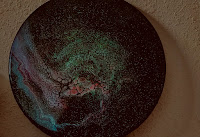MEXICAN SQUASH, LENTILS, RADDISH SPROUTS AND BERRIES SALAD
I cooked the golden lentils and choyote together in a lidded earthenware cooker with slivers of ginger and some liquids of water peppermint extract and Nigerian herbs I bought in Brooklyn. The rest of the ensemble will be cold and fresh washed (and air dried; snip off the root tendrils of the sprouts) to mix in later with a simple champagne dressing. Toast bread with it as you like, and for the non-vegan make a charcuterie board of Bulgarian feta cheese to build extra flavor on your buttered toast, but I like mine as is. Writing a home recipe is metaphorically following your appetite for all the combinations of taste that will work for you, as savory as can be; food-writing is like it’s soul elevated before the plate. A “story” can’t work if it doesn’t taste good.
This blog was created in the summer of 2011 and ever since I had written here what came out of eating I cooked home. This could be an opportunity to reminisce some highlights I remember by heart as favorites “cook review.” Immediately I think of Argentina— the pastoral wine country in Mendoza, the smoky parrillas (barbecue techniques) and oozing baked empanadas in Buenos Aires. I had studied with chef Manuel in his studio in Palermo, but he admitted his wife was the better cook. Dulce de Leche. The phenomenal locro soup/stew of corn cobs, carrots and saffroned tomatoes served with rice. I went to Tigre Delta to capture in sketches of painting the rustic villages built along the tributaries where rare lilies of reeds abound and navigable only by canoes. I retuned to New York full of recipes bound in a black folder, and top page was how to make a chimichurri.
Some readers have followed me through this decade-long food journey and it won't be a surprise to them that I left my heart in Paris. I had a routine from the airport directly after depositing my luggage at the hotel to walk over to my favorite boulangerie in the 11th arr. and get my quiche and baguette and while eating walking stop by a flower vender on the street and get a bouquet for my cousin waiting at the steps of Jardin du Plantes by the Siene and when there we would kiss both cheeks and she'd say welcome home honey. Food is beside the point in Paris. I go there to eat well for poetry's sake. It's a hungry companion only satiated spiritually by a kindred artist. And there's only one who is that. I fall in love with the world and one travel memory I had accidentally fell too in love against reality that me and my cousin recoursed to bury that memento in the waters of Île de la Cité, crying with held hands. Weeks later in my apartment in Manhattan I received a postcard from her of that same spot (the card was a caricature watercolour but the metaphor was there) of that romantic island on the Seine with these guiding words, quoted from Aldous Huxley: ... even if your feeling deeply, go lightly, my child, go lightly.

 Nato (pronounced nah-to) is ultra fermented soybeans essential delicacy in Japan and slimy odorous (as sharp miso) but mega good for you, protein-rich in molecular amino acids and beta carotin. I had a discussion with a vegan/nature worshiper/surfer originally from N. Carolina deep in the oasis forest of Iao where we swim, and after meditating on the granite cascades of the spring hungered for the bodily and mindful benefits of this food. Our chosen nutrition lifestyle is like mortal abstinence: we are both in a spiritual journey, his more nomadic geopolitical (freedom from capitalistic attachments living freely day by day elevating his "home" to a universal vibration); mine, on the other hand, is more religious (in the sense a personal search guided by the philosophy of Buddhism and poetics, achieving intellectual and creative evolution). And yes, we both believe these pure sources from plants and traditional techniques as food can pave the way.
Nato (pronounced nah-to) is ultra fermented soybeans essential delicacy in Japan and slimy odorous (as sharp miso) but mega good for you, protein-rich in molecular amino acids and beta carotin. I had a discussion with a vegan/nature worshiper/surfer originally from N. Carolina deep in the oasis forest of Iao where we swim, and after meditating on the granite cascades of the spring hungered for the bodily and mindful benefits of this food. Our chosen nutrition lifestyle is like mortal abstinence: we are both in a spiritual journey, his more nomadic geopolitical (freedom from capitalistic attachments living freely day by day elevating his "home" to a universal vibration); mine, on the other hand, is more religious (in the sense a personal search guided by the philosophy of Buddhism and poetics, achieving intellectual and creative evolution). And yes, we both believe these pure sources from plants and traditional techniques as food can pave the way. 



Social icons